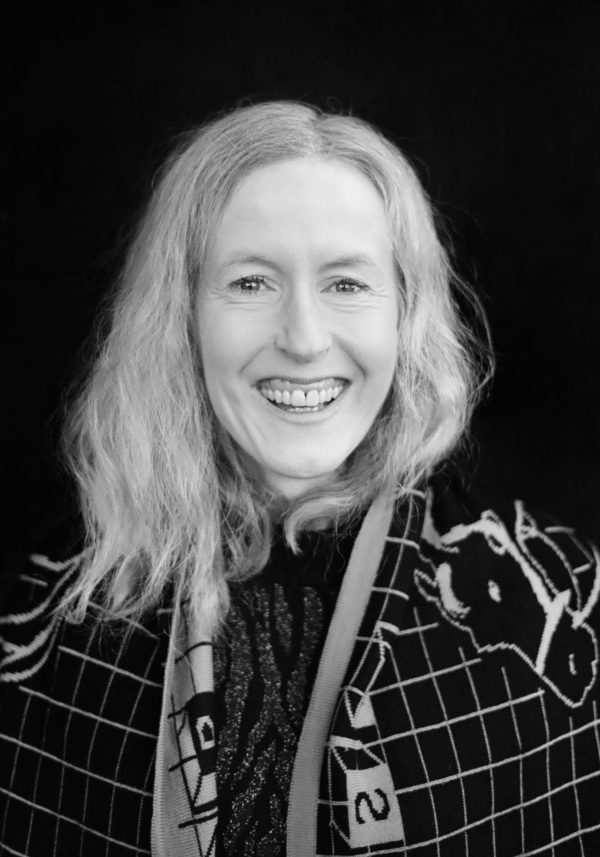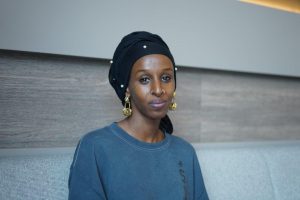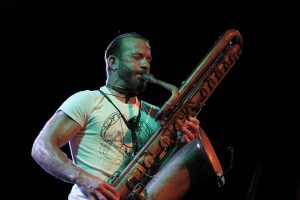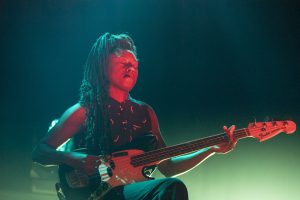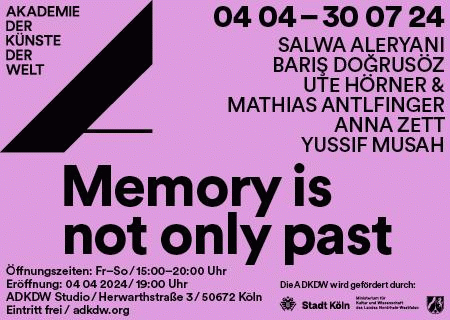Jennifer Walshe ‘As humans we struggle with events that are outside of our control’
‘If people turn up – unless being obnoxious, or throwing things at you – your duty is to try to meet them halfway. Hopefully, they are curious. I know what it feels like to feel exhausted and not like going to a concert and to prefer to stay home. A lot of people work extremely long hours or work multiple jobs, so if they commit going to a concert, we have to have respect for that.’
As Jennifer Walshe utters these words on that sunny afternoon, 7 February 2020, on the banks of the Rhine in Monheim in Germany, the Irish composer, performer, and university lecturer has no idea that just one month later the world as we know it would be turned upside down. The first wave of lockdowns was to hit Europe unprepared, despite preceding events in China, sending the social, economic, and also cultural subsystems into a state between fear and helplessness that continues to this day.
Jennifer Walshe continues to talk with enthusiastic sparkling eyes about the plans she still has for the Monheim Triennale in summer 2020 – which has now become the silver lining for summer 2022, when the first edition of the Monheim Triennale should finally take place.
‘Everything is important’
Central to several performances Jennifer Walshe will present in Monheim is her piece ‘Everything is important’, a composition for voice, string quartet and film, which Walshe will perform together with New York Mivos String Quartet (consisting of Olivia de Prato on violin, Maya Bennardo, Victor Lowrie Tafoya and Tyler J. Borden), the singer Tomomi Adachi and electronic musician Mario de Vega. The film sequences for the performance are based on footage Walshe herself specifically filmed, including in Ireland’s only nuclear bunker in Limerick.
‘In the piece I was trying to talk about how people are afraid of things. Because I think a part of the texture of being alive right now is that there are lots of things we feel afraid of’. She continues to dig into the background, ‘After 9/11 happened, the Irish government issued a package of Iodine tablets to every family in the country and said: “If there is a nuclear attack, you should take these Iodine tablets.” There isn´t enough in one package for one adult, but every family I know has kept their little package almost the same way they keep the statue of the Virgin Mary around. Just because it helps these things to not happen. As humans we struggle with events that are big, that are outside of our control, whether they are just regular day things like somebody we love getting sick and dying or like attacks or pandemics. I am interested in looking at that in my work.’
‘XXX_Live_Nude_Girls!!!’ & the Universe
In her music and conceptual work, Jennifer Walshe has always explored the way we humans create oral histories, using her own body and all her vocal cords. Her songs are often highly idiosyncratic, virtually adhering to the composer and singer long after the sounds have passed her lips. And yet no piece by Jennifer Walshe is conceivable without an immediate audience and society as a larger sound space. Her compositions are poised in the tension between musique concrete, minimalism, electro-acoustic as well as vocal music. They are characterised by fascinating exploratory themes and thus so suited for those less formal performance contexts that Walshe prefers for their delivery. Her pieces are as much at home in large opera houses and theatres as they are in intimate venues such as ‘Zum goldenen Hans’, where she performed together with Angelika Sheridan and Achim Tang during her first visit to Monheim in February 2020.
The topical range Walshe manages to cover spans from a popular music theme such as Barbie dolls (to whom she dedicated the opera ‘XXX_Live_Nude_Girls!!!’ to, where a doll is raped on stage) to the opera ‘Time Time Time’, co-written with philosopher Timothy Morton, which aims to make nothing less than our planet’s history sonically tangible.
It’s clear: Jennifer Walshe is not afraid to bite off more than she can chew. She also stresses that her artistic partners play an essential role in the development process, so it is not solely their courage and willingness to experiment which paves the way. A composition for an orchestra like the Irish RTÉ National Symphony Orchestra, for example, requires clear notation in order to do justice to the structural circumstances (changing musicians, rehearsals…). The composition for the Monheim Triennale also contains sections with musical scores’, she remarks, ‘but also parts which allow the Mivos String Quartet more freedom, as this is the only way to create the desired sound textures.’
She illustrates her process with another example:
‘I took electromagnetic microphones and put them on my laptop, then I deleted everybody I did not like from my facebook account and made this recoding of the sounds that my actual laptop is making. I use this as a drone and let the string quartet play across – and ask them to sort of try to fight one another by making tiny, short quotations from famous string quartets to see if other members of the quartet know what it is and can answer the end of the phrase. In that situation I am working with four players that have probably a century of experiences between them, why wouldn’t I use that and get this detail and richness and get this sense of lightness on the stage.’
Stories like this introduce you to Jennifer Walshe’s sound space, which is certainly not always an easy place to be. ‘But that should by no means mean that she is obliged as an artist to always provide such background information’, Walshe emphasises. ‘And one should certainly not expect the listeners to pick up on it. In the end, it’s all about the sound anyway. If it doesn’t sound interesting, then even the best background anecdote won’t help’, says Walshe. ‘This is where I differ from many others who are true conceptual artists, along the lines of “staying true to your thing, have an idea and stick with it.” I use these conceptual approaches to see what I can get out of the material.’
Tony Conrad: ‘Why don’t you do that?’
In the years before his timely death, Jennifer Walshe worked intensively with American musician and visual artist Tony Conrad – a match made in heaven. Conrad, who knew how to combine minimalism, Dadaism, and experimental music in his work like hardly anyone else, was a kind of late mentor for Walshe. He encouraged her that there is no such thing as too absurd a scenario for an artist, and at the same time he made her aware of the immense importance of respect and appreciation of the audience. That she really understands this is quite evident from her initial quote in this article.
Conrad and Walshe met in 2009 at the Electric Eclectics Festival in Meaford, Ontario, which is organised by Canadian experimental musician Gordon Monahan on his farm.
‘A very interesting festival in the middle of nowhere’, Walshe starts to elaborate. ‘Everybody camps, I had to sleep in the woodshed when I was there.’ As luck would have it, they both lived in the same neighbourhood in Brooklyn. After the festival they met more and more often, at first just for the sake of it, but soon to just make music together.
For their productions, they often travelled to Tony Conrad’s legendary house in Buffalo together, which he once rented as the set for the never-completed movie ‘Jail’ (with Mike Kelley and Tony Oursler) and purchased later on. The ideal place to experiment with music without self-imposed and/or external boundaries. On occasion, Conrad liked to wear women’s clothes’, Walshe recounts. ‘And why not?’ Allowing yourself to do whatever you feel like, even consciously confronting your own fears, was always of immense importance to him – and shaped Jennifer Walshe’s further artistic path.
If you look at her work ‘The Total Mountain’, you are instantly reminded of Cindy Sherman, the great American artist of transformation, who chooses her own body as the starting point for her photographic storytelling. ‘I really enjoy how even things like costumes can change how you think about your body – and how that changes your energy on stage. What make up can do… it can change even the sounds you make.’
From Cindy Sherman it’s only a few steps to Madonna and above all Prince. On this day on the banks of the river Rhine, Walshe doesn’t just express her love for Prince Rogers Nelson and his ‘crazy costumes and poses’, but also because of his audacity in abandoning his artist name and replacing it with ‘Love Symbol #2’.
This brings her back to the aspect of artistic freedom, which she only allowed to this extent owing to the advocacy by Tony Conrad: ‘He was completely free when he was playing. You know, he would headstand and sing a song, he would not care, if you want to roll on the ground, he did not care. He didn’t have a territory that he had decided on and wanted to stick with.’
Jennifer Walshe: ‘You mean, that would be okay?’
When asked about what influenced her, Jennifer Walshe refers to her father, who was a big jazz fan and introduced her to the music of Bill Evans, Miles Davis, and John Coltrane. Music which she had found beautiful from an early age and which had inspired her to learn an instrument. The object of her desire, the trumpet. Even back then, a decision based purely on its sound.
The great artistic catalyst, however, occurred during her studies in the U.S., when her composition teacher gave her the assignment to spend each week in the library studying the body of works by a different composer. The first teacher’s assignment: Meredith Monk.
Walshe recalls: ‘I went to the library and got the CD ‘Our Lady Of Late’ – a whole CD of solo voice, except for two tracks with the crystal glass that she is playing. She made all the work and she performed it all – and I just had this moment: ‘That’s how you do it! You make your own stuff, and you perform it. Then you could do whatever you want.’
Of course, I knew about composers who played their own work, like Bach, but it was different to see it in the context of Meredith Monk. Even though my music does not sound anything like hers, that concept was a huge influence on me as a young one – I was 23 years old at that time.’
For Jennifer Walshe’s own identity, her lyrics are of immense importance. She also has Tony Conrad to thank for that. ‘He said, ‘why don’t you do that?’, Jennifer Walshe recalls one of the most important conversations in her artistic life. ‘Because up to then I did a lot of writing in my work, but I did not use a huge amount of text when I performed, because there are a lot of free improvisers out there who don’t like it or find it difficult when vocalists are using text. And I understand, because cognitively our brains are wired, we’re going to prioritise whatever comes out of somebody’s mouth – and if what is coming out of the person’s mouth is text, we double prioritise that. So if you got this free improv line-up and somebody stands up and starts singing text, everybody’s attention is going over to that person.
‘But Tony one day said to me: “I don’t understand, you love writing, why are you not using text when we improvise?”
‘And I really felt: ‘You mean, that would be okay?’ – and he was: ‘Yes, of course.’ That was the beginning of me working in that way. I am eternally grateful that he opened the door that he knew I was standing behind.’
Today, it is impossible to imagine Jennifer Walshe’s work and performances without these texts. They are, so to speak, the start and the end of her world – and everything in between. This is not only due to their constant presence, but above all due to the fact that they do not exist in one prescribed form; her texts are as vibrant as the composer, lyricist, and interpreter herself. ‘When I make pieces with text, I work on that text and I test it and I change it’, Walshe elaborates. ‘With this audience I get maybe a little bit further with the text, with that audience I don’t go quite as far in the text.’
During our more than two-hour long conversation, she immediately has an example at hand that makes her statements tangible: ‘If I can go back to Meredith Monk, I remember seeing her in Berlin. And she took this new piece of manuscript paper out of her pocket and unfolded it and put it on the piano: ‘I haven’t memorized it yet.’
And you realize she is testing the pieces in front of audiences and then changes a little bit before she locks it down in the final version. I would bet that something that I and all of the other performers of the Monheim Triennale share in common, is that we are aware of what that can do and how useful it is and how interesting it is to let things change a bit. And then you record it and make a finished document of it or you have a final version that is 99% the same as the gig, but that one percent is always magic, how it changes.’
‘I am open for anybody’
In the meantime, we are at ‘Zum goldenen Hans’ in the centre of Monheim – established as a temporary exile for the team and the youths of Sojus 7 during its renovations, at the time of writing. The small club with the inviting large window front has long since become quite a special place for cultural encounters in Monheim.
‘I am open for anybody’, a couple of hours before the performance Jennifer Walshe summarised her motto for improvisation performances and talked about a joint performance with M.C. Schmidt (from the band Matmos) at the High Zero Festival in Baltimore to illustrate how this openness works for her. ‘It is the only free improve festival I have ever played at where the inviter is an individual and then they just tell you whom you will be playing with. You never met the people before, you never worked with them before, I think they have a picking party where they decide who will be a good fit. So at High Zero you see some sets which are stunning, they made this arranged marriage that is amazing. And then you see some sets where it is really a struggle.’
Jennifer Walshe trained her improvisation skills in Chicago, where she studied at Northwestern University in the early noughties. ‘The first time that I saw Evan Parker play was at The Empty Bottle’, she recalls about a particularly influential concert which opened the doors to a community with a lasting impact for her. ‘There were lots of older, more experienced players. And they were really happy to have you as kids in your twenties play support. You know, we opened for them. So people like Harold Giannetti, Eric Lanerdsen, Gene Colman, Lambert Home, all those people in that scene, you will go and just play a 25-minute set opening for them. They would play and you watch them and learn from them. And then they call you up on the stage and you do a little ten-minute set together at the end. I thought that was really fantastic, because we were able to play in public – which is really important, because you don’t really know how it goes until you play in public. But also, we got to see the people with more experience play and learn from that. We were barely wet behind the ears, so to speak, with this whole genre. But the community was welcoming, willing to let us fail – and they were including us. That seemed to me a pretty beautiful way of making music.’
Free improvisation at ‘Zum Goldenen Hans’
And yes, it is only possible to really understand the artist Jennifer Walshe once you’ve experienced her improvising live. In her performances, the Irishwoman’s various roles come together. Composer and interpreter become one, the performer complements the conceptualist and, in general, the curiosity and joy of artistic dialogue is multiplied many times over.
In ‘Zum goldenen Hans’ she plays together with the Monheim Triennale Artist in Residence Achim Tang and Angelika Sheridan, who has been teaching at the music school in Monheim for many years. It is fascinating to see how Walshe experiments not only with her voice, but with her entire body. Her movements can be irritating at first because of their inherent contradictions. However, they are tender and harsh at the same time. But this is only matching the sounds Sheridan and Tang cultivate, a combination of Eastern European, very American, and European styles, held together by the wonderfully warm basic feeling and guided by the Tang’s rhythm on bass.
Achim Tang recalls that performance: ‘It was an equally exciting and challenging evening for me. I don’t meet musicians of this calibre for a live performance on a daily basis. An inspiring and exciting occasion! At the same time, in my role as the ‘host’ of the concert, I was concerned about how people would handle the music, which was obviously very unfamiliar to them. I remember a very funny moment towards the end of the concert when both we and some of the listeners had to laugh out spontaneously. That’s when you sense an immediate contact that puts all the tension into perspective. This was also confirmed during the talks after the concert. The possibility of being able to react in this way, without being labelled ‘behaving inadequately’, crucially influenced the experience, the ‘understanding’ of this music’.
‘For me free improvisation is like an engine, that´s at the core of everything that I do’, Jennifer Walshe told me just before the concert. A statement that only really makes sense when you see how she gets involved with Sherdian and Tang, ready to be led to places and conditions that had not been spelled out before.
‘It is sort of like the source code. A lot of my pieces they are generated out of me improvising and taking bits and then massaging and developing them. It is not just a way of making material, it is also a way of being in a community, getting to know people, playing with them – being part of a community that cares about a certain type of art.’
Jennifer Walshe never tires to emphasise that her understanding of community and improvisation always includes the audience. ‘There is an element of risk with free improvisation that means the audience is just as important a part for the performance as the performers. It is a way of getting to know people. It is a way of having to negotiate the most basic human stuff: how to listen to one another, how to give space for one another, whether to intervene, whether to leave things as they are. Just these absolute base human skills and ways of moving to the world. That is something that I love, the key to who I am as a composer.’
A look into the eyes of the audience at ‘Zum goldenen Hans’ shows both sides feel very much the same about it. While certainly not everyone present was acquainted with Jennifer Walshe’s work before, and undoubtedly free improvisation is not part of everyone’s daily listening, the connection was palpable. This unique magic of music, of bringing people from different cultural backgrounds together, that is what we are all sorely missing since COVID-19 started, relegating us into cultural isolation. It’s about time musicians like Jennifer Walshe can once again take us into their world.
Jennifer Walshe is one of the 16 artists originally invited to the Monheim Triennale. The first edition of the Monheim Triennale is now scheduled for the 22nd till 26th of Juni 2022 statt. From 1st till 4th of July 2021 the Monheim Triennale presents their special edition “The Prequel”, including Jennifer Walshe among many others of the original Triennale roster.
This text was initiated by the Monheim Triennale. More editorial feature on the artists of the Monheim Triennale are to be found on the website of the festival under the section “Monheim Papers”.









